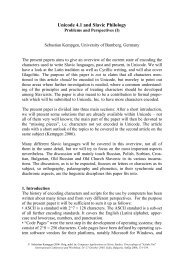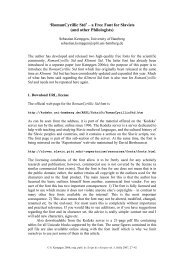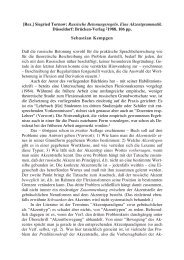Sebastian Kempgen Unicode 4.1 and Slavic Philology ... - Kodeks
Sebastian Kempgen Unicode 4.1 and Slavic Philology ... - Kodeks
Sebastian Kempgen Unicode 4.1 and Slavic Philology ... - Kodeks
Create successful ePaper yourself
Turn your PDF publications into a flip-book with our unique Google optimized e-Paper software.
<strong>Sebastian</strong> <strong>Kempgen</strong><br />
<strong>Unicode</strong> <strong>4.1</strong> <strong>and</strong> <strong>Slavic</strong> <strong>Philology</strong><br />
Problems <strong>and</strong> Perspectives (II)<br />
0. Introduction<br />
In the first paper devoted to the current state of encoding <strong>Slavic</strong> characters into<br />
<strong>Unicode</strong> (KEMPGEN 2006) 1 we gave an introduction to the topic, outlined various<br />
achievements in the current version of <strong>Unicode</strong> (v. <strong>4.1</strong>, 2005), mainly because<br />
not all of them are common knowledge or available in st<strong>and</strong>ard fonts like<br />
Times or Times New Roman, <strong>and</strong> then we discussed many of the historic or<br />
special characters of the <strong>Slavic</strong> languages that have not yet been encoded in<br />
<strong>Unicode</strong>. Space did not permit us to cover everything in the first article, so this<br />
second article will take up where the first paper left, <strong>and</strong> will also present more<br />
illustrative material for some of the topics from the first article. The reader<br />
might find it useful to be familiar with the first article before reading the present<br />
one, but knowledge of the first article is not a prerequisite.<br />
As for the first paper, it should be noted that the purpose of this paper is<br />
not to claim that all characters mentioned in this article should be encoded in<br />
<strong>Unicode</strong>, but merely to point out those areas where further investigation is<br />
needed, where a common underst<strong>and</strong>ing of the principles <strong>and</strong> practice of treating<br />
characters should be developed among <strong>Slavic</strong>ists. The paper is also meant<br />
to be a contribution to formal proposals which will be submitted to <strong>Unicode</strong>,<br />
Inc. to have more characters encoded.<br />
One important thing that is also worth repeating is that if a character, may<br />
it be a letter, an accent or some other sign, is defined in <strong>Unicode</strong>, that does not<br />
mean that a certain font contains an image of that character. Thus, it would be a<br />
misconception to think that because font X does not have character Y, Y is not<br />
available in <strong>Unicode</strong>. Most people today will, for example, use Times New Roman<br />
(from Monotype) on the PC (<strong>and</strong> now on the Macintosh, too), <strong>and</strong> Times<br />
(from Linotype) on the Macintosh. A comparison of these two common fonts<br />
(see Appendix) will show that, unfortunately, Times New Roman has less to<br />
offer to a <strong>Slavic</strong>ist than Times, but Times is not as widespread on the PC<br />
whereas on the Macintosh it is a st<strong>and</strong>ard since the invention of desktop publishing<br />
in the 80’s (although of course only now under OS X with an extended<br />
<strong>Unicode</strong> character set). 2<br />
1 Available electronically from the ‘<strong>Kodeks</strong>’ server: http://kodeks.uni-bamberg.de/<br />
2 It might be worth pointing out that version 3.05 of both Times New Roman <strong>and</strong> Arial<br />
for the Macintosh have the same character set as their PC counterparts. Thus, any data<br />
<strong>and</strong> file exchange that is based on these fonts will be completely without problems.<br />
© <strong>Sebastian</strong> <strong>Kempgen</strong> 2006; orig. publ. in: T. Berger, J. Raecke, T. Reuther (Hgg.),<br />
Slavistische Linguistik 2004/2005, München 2006, 223-248.
224 <strong>Sebastian</strong> <strong>Kempgen</strong><br />
To make up for the deficiencies in the st<strong>and</strong>ard fonts mentioned above, the<br />
author of the present article has produced a font named Kliment Std that is<br />
available for free. This font is aimed especially at <strong>Slavic</strong> medievalists, <strong>and</strong> it<br />
features a lot of those characters not present in the above-mentioned reference<br />
fonts. ‘Kliment Std’ is available for download from<br />
http://kodeks.uni-bamberg.de/AKSL/Schrift/KlimentStd.htm<br />
<strong>and</strong> also from the ‘Repertorium’ website. It is being used in the present paper<br />
where the st<strong>and</strong>ard fonts do offer support for a character in question.<br />
1. <strong>Unicode</strong> Blocks<br />
For practical purposes, <strong>Unicode</strong>, a table consisting of 65.536 cells in which<br />
each character has its own unique number <strong>and</strong> also a name, is normally organized<br />
into “blocks”. Thus, for example, all Cyrillic characters for the <strong>Slavic</strong><br />
languages form one block, Soviet additions to the Cyrillic alphabet form another<br />
block etc.<br />
Fig. 1: Cyrillic <strong>Unicode</strong> Block (‘Lucida Gr<strong>and</strong>e’ font)<br />
This pertains to the Latin accented characters used by today’s <strong>Slavic</strong> languages, <strong>and</strong> to<br />
the contemporary orthography of Cyrillic. The differences – <strong>and</strong> problems – however<br />
begin to start immediately beyond that point.<br />
© <strong>Sebastian</strong> <strong>Kempgen</strong> 2006; orig. publ. in: T. Berger, J. Raecke, T. Reuther (Hgg.),<br />
Slavistische Linguistik 2004/2005, München 2006, 223-248.
<strong>Unicode</strong> <strong>4.1</strong> <strong>and</strong> <strong>Slavic</strong> <strong>Philology</strong> II 225<br />
2. Notes on available characters <strong>and</strong> solutions<br />
2.1. The Uk ligature<br />
Among the historical additions to the <strong>Slavic</strong> block there is the ‘Uk’ digraph, i.e.<br />
Oy / oy. Sometimes this character is rendered as a digraph, <strong>and</strong> sometimes as a<br />
vertical ligature, i.e. ! " (see Fig. 1). However, one can either have the digraph<br />
or the ligature in the <strong>Slavic</strong> Cyrillic block, not both.<br />
Just browsing through all characters available in a given font will, however,<br />
reveal the presence of ! " at another location: They are available as Latin<br />
letters in the Latin Extended-B block, character codes [0222] <strong>and</strong> [0223]. This<br />
is somewhat unexpected because it is well known to Slavists that these characters<br />
were introduced into the Cyrillic alphabet under the influence of the Greek<br />
alphabet <strong>and</strong> its writing conventions. In the Greek section of <strong>Unicode</strong>, however,<br />
these vertical ligatures aren’t available. The reason why the vertical ligature<br />
is not present in <strong>Unicode</strong> as a Greek character is because Greek official<br />
bodies vetoed its introduction on the basis that it’s use is ‘a mistake’, <strong>and</strong> that it<br />
will be corrected by teachers. However, the vertical ligature is being used today<br />
even in printed form, see Fig. 2 for an example in the name of a famous Greek<br />
biscuit company.<br />
Fig. 2: Greek vertical OY ligature in use today<br />
Anyway, from the Greek alphabet the ligature found its way into the alphabets<br />
of the Algonquin <strong>and</strong> Huron languages. Thus, the Greek vertical ! " became a<br />
Latin letter present in two Indian languages but the language it was borrowed<br />
from, Greek, does not have that character in <strong>Unicode</strong> because officials did not<br />
like it there, <strong>and</strong> the need of philologists wasn’t considered relevant enough to<br />
overturn the official vote.<br />
Now from a user’s st<strong>and</strong>point it wouldn’t make much of a difference if the<br />
! " is a Greek, a Cyrillic or a Latin letter – if it’s there, it can be used. That’s<br />
indeed true, but it is also true that one will then have a mixture of Greek <strong>and</strong><br />
Latin letters within one word, or of Cyrillic <strong>and</strong> Latin. This has negative side<br />
effects on sorting, spell checking, hyphenation etc. <strong>and</strong> such a mixture of characters<br />
should be avoided. For the very same reasons, <strong>Unicode</strong> has a Cyrillic ‘A’<br />
even if already has a Latin ‘A’!<br />
The same observation is also valid for other characters: Cyrillic characters<br />
not yet available in <strong>Unicode</strong> may look identical to Latin characters elsewhere in<br />
other <strong>Unicode</strong> blocks, <strong>and</strong> thus it is tempting to use them instead. However, as<br />
© <strong>Sebastian</strong> <strong>Kempgen</strong> 2006; orig. publ. in: T. Berger, J. Raecke, T. Reuther (Hgg.),<br />
Slavistische Linguistik 2004/2005, München 2006, 223-248.
226 <strong>Sebastian</strong> <strong>Kempgen</strong><br />
we wanted to point out here, that is not the ideal approach, although certainly<br />
practical if no other solution is available at a given time.<br />
2.2. Long <strong>and</strong> short vowels<br />
Available in <strong>Unicode</strong> are precomposed characters for most long <strong>and</strong> short vowels:<br />
Long vowels: # $ % & ' (<br />
Short vowels: ) * + , - _<br />
What’s missing from this chart is a short y, which, however, can be composed<br />
from its parts: y.. One may be tempted to simply use the Byelorussian character<br />
instead, which looks identical. While for a printed text or an on-screen representation<br />
it makes no difference whether the y. is Cyrillic or Latin, this distinction<br />
is important for settings concerning the language of the text in a wordprocessor<br />
file, for hyphenation, for sorting etc., i.e. for text processing <strong>and</strong> text<br />
encoding – see above.<br />
3. Problems in <strong>Unicode</strong> <strong>4.1</strong> – continued<br />
3.1. !tokavian Accents – the missing double grave accent<br />
Serbian <strong>and</strong> Croatian use four accent marks to denote the four possible combinations<br />
of long vs. short duration with rising vs. falling tone. The accepted<br />
norm uses acute ( ´ ) for long-rising, grave ( ` ) for short-rising, an inverted bow<br />
( / ) for long-falling <strong>and</strong> a double grave accent ( 0 ) for short-falling. These four<br />
diacritics go over any of the following six vowels: a e i o u r, totalling 6 x 4 =<br />
24 different character combinations. Of these 24 characters, 23 are covered as<br />
precomposed characters by <strong>Unicode</strong> <strong>4.1</strong>, while one has been forgotten: r with<br />
grave accent: r1. This omission was treated more fully in the first article. As one<br />
can see from the preceding sentences, it is sometimes necessary, when one<br />
writes about accents, to typeset them by themselves. This is why <strong>Unicode</strong> has<br />
among its blocks a section devoted to ‘spacing modifiers’, i.e. accents with<br />
their own positive width, <strong>and</strong> a section devoted to ‘combining diacritics’, i.e.<br />
accents which have zero-width, i.e. which will not move the insertion point in a<br />
word-processor, <strong>and</strong> which will be displayed instead above or under the preceding<br />
character. Such ‘combining diacritics’ are also known as ‘flying accents’.<br />
While most accents required for <strong>Slavic</strong> phonetics are available as spacing<br />
accents as well as non-spacing accents, the one accent missing is the double<br />
grave accent. It is available in the ‘Combining Diacritical Marks’ block at<br />
[030F], but not in the ‘Spacing Modifiers’ section. There, however, we find a<br />
“modifier letter middle double grave accent” at number [02F5] among several<br />
other “middle” modifiers. They all differ from normal modifiers in their height:<br />
© <strong>Sebastian</strong> <strong>Kempgen</strong> 2006; orig. publ. in: T. Berger, J. Raecke, T. Reuther (Hgg.),<br />
Slavistische Linguistik 2004/2005, München 2006, 223-248.
<strong>Unicode</strong> <strong>4.1</strong> <strong>and</strong> <strong>Slavic</strong> <strong>Philology</strong> II 227<br />
they do not sit above characters but to the side of them: x0x. In other words: a<br />
normal spacing modifier double grave accent is missing from <strong>Unicode</strong> at present<br />
<strong>and</strong> should be added as a ‘spacing clone’ of the corresponding combining<br />
diacritic.<br />
3.2 . Sorbian <strong>and</strong> Polish orthography<br />
In the first article on this subject, we already mentioned that for Sorbian several<br />
characters are missing. We will be presenting some additional illustrations<br />
here.<br />
Fig. 3: Character table from !"ela (1952, 1).<br />
The characters that are not available in <strong>Unicode</strong> are precomposed b’ <strong>and</strong> f’,<br />
which may not really be necessary given that they can be composed from their<br />
parts quite satisfactorily, <strong>and</strong> the long s ( # ) with stroke. See Fig. 5 for some<br />
more samples. The long s with stroke is an addition to <strong>Unicode</strong> that would be<br />
needed. Because this character was always <strong>and</strong> only printed using broken script<br />
fonts (‘Fraktur’), the lowercase character is not the ‘normal’ s, but the long s<br />
( # ). Implemented for a modern typeface, it would look like this:<br />
Fig. 4: Serifed design of S <strong>and</strong> long s with stroke<br />
© <strong>Sebastian</strong> <strong>Kempgen</strong> 2006; orig. publ. in: T. Berger, J. Raecke, T. Reuther (Hgg.),<br />
Slavistische Linguistik 2004/2005, München 2006, 223-248.
228 <strong>Sebastian</strong> <strong>Kempgen</strong><br />
Fig. 5: Character samples from !"ela (1952, 3).<br />
In the history of Polish orthography, the work of Jakub PARKOSZ (ca.<br />
1440) st<strong>and</strong>s out as the first attempt to distinguish hard <strong>and</strong> soft characters. In<br />
the first part of the article on <strong>Slavic</strong> philology <strong>and</strong> <strong>Unicode</strong>, we already presented<br />
a scan from modern printed editions of his works. We will present here<br />
the h<strong>and</strong>written original:<br />
Fig. 6: Character samples from J. Parkosz (URBA$CZYK/OLESCH 1985, 53)<br />
Here, one can se the square <strong>and</strong> round b in the first line under the Latin descriptions<br />
‘grossum’ (hard) <strong>and</strong> ‘molle’ (soft), <strong>and</strong> the square <strong>and</strong> round p in<br />
the third line, again with ‘grossum’ <strong>and</strong> ‘molle’ above them. As was already<br />
stated in the first article, Parkosz’s suggestions never became popular even<br />
© <strong>Sebastian</strong> <strong>Kempgen</strong> 2006; orig. publ. in: T. Berger, J. Raecke, T. Reuther (Hgg.),<br />
Slavistische Linguistik 2004/2005, München 2006, 223-248.
<strong>Unicode</strong> <strong>4.1</strong> <strong>and</strong> <strong>Slavic</strong> <strong>Philology</strong> II 229<br />
with his contemporaries because these distinctions were hard to realize <strong>and</strong><br />
more a question of writing styles or font design than true graphemes.<br />
We will present additional here material concerning the so-called r rotunda,<br />
the ‘round r’. Just as the Latin s is available in <strong>Unicode</strong> in two forms, the<br />
st<strong>and</strong>ard form <strong>and</strong> the long s, the r rotunda needs to be encoded as the second<br />
form of the r:<br />
Fig. 7: r, r rotunda, s, <strong>and</strong> long s (‘Breitkopf’ font)<br />
In contrast to German, in Polish the r rotunda carried a functional load: it<br />
helped to distinguish -rz- [%] from -r-z- [rz] (see URBA$CZYK/ OLESCH 1985, 36<br />
on Murzynowski 1551). The r rotunda was also in use for Sorbian, see the second<br />
line of the table in Fig 8:<br />
Fig. 8: Alphabet chart from MUCKE (1891; repr. 1965, 18)<br />
© <strong>Sebastian</strong> <strong>Kempgen</strong> 2006; orig. publ. in: T. Berger, J. Raecke, T. Reuther (Hgg.),<br />
Slavistische Linguistik 2004/2005, München 2006, 223-248.
230 <strong>Sebastian</strong> <strong>Kempgen</strong><br />
3.3. Unified Jers <strong>and</strong> Nasals<br />
In Cyrillic texts, we find a so-called ‘unified jer’, which is written as a middle<br />
form between the two st<strong>and</strong>ard jers, <strong>and</strong> we also find so-called ‘unified nasals’:<br />
Fig. 9: Unified Jer <strong>and</strong> unified nasals (‘Method’ font)<br />
All these character pairs are not yet available in <strong>Unicode</strong>. Their very essence<br />
lies in the fact the scribes could not decide or did not know or were not aware<br />
of which one of each pair to write, <strong>and</strong> therefore they went for a middle form.<br />
This, of course, means that these middle forms cannot be identified with either<br />
one as being a stylistic variant. At this point, it should be noted that these ‘unified’<br />
letters are not identical to the characters used in the so-called ‘one-jertexts’<br />
which exhibit only one of the jers, but where the form of this letter is<br />
clearly one of the two.<br />
3.4. Transliteration of Glagolitic Nasals<br />
Now that the Glagolica has been included in <strong>Unicode</strong> in its version <strong>4.1</strong>, it is<br />
only logical to check if all characters needed for the transliteration of Glagolitic<br />
into Cyrillic are available. First problems in this area were noted in the first<br />
article – the case of the missing Cyrillic Iota.<br />
The transliteration of the nasal vowels from the Glagolitic alphabet into<br />
Cyrillic letters presents another currently unsolved problem. Let’s have a look<br />
at the transliteration:<br />
! " 2 ✓<br />
# " 3 ¬<br />
$ " 4 ✓<br />
% " 5 ✓<br />
& " 6 ✓<br />
' " ‘YO’ ¬<br />
The ! – nasal E (first line) – can be transliterated into Cyrillic. In the second<br />
line, there is special character that occurs in Zographensis <strong>and</strong> in Marianus: #;<br />
it is encoded in <strong>Unicode</strong> as a separate glyph even if it is recognized to be a<br />
variant of the glyph in the first line.<br />
© <strong>Sebastian</strong> <strong>Kempgen</strong> 2006; orig. publ. in: T. Berger, J. Raecke, T. Reuther (Hgg.),<br />
Slavistische Linguistik 2004/2005, München 2006, 223-248.
<strong>Unicode</strong> <strong>4.1</strong> <strong>and</strong> <strong>Slavic</strong> <strong>Philology</strong> II 231<br />
Fig. 10: Variants of EN in <strong>Unicode</strong><br />
According to TRUBETZKOY, the glyph # denotes a nasal O; however, because<br />
its shape is derived form the nasal E (! < #), it is usually transliterated<br />
using a modified Cyrillic nasal E (3 < 2) whose form actually occurs in Suprasliensis<br />
(but is not encoded as a separate letter in <strong>Unicode</strong>). Consequently,<br />
the 3 should be added to the Cyrillic block not only in its own right, but primarily<br />
because it is needed to transliterate #.<br />
The jotated nasal E ($), the nasal O (%) <strong>and</strong> the jotated nasal O (&)<br />
can all be transliterated, as lines three to five show. However, sometimes the<br />
need arises to single out the first part of the jotated nasal O, i.e. ', for example,<br />
to write about it, <strong>and</strong> it also seems to occur in a non-connected form in actual<br />
manuscripts. Here, the situation becomes even less clear: it is unclear how to<br />
transliterate this part into Cyrillic; sometimes we simply find the Latin digraph<br />
‘YO’ although it clearly does not represent the phonetic value correctly.<br />
TRUBETZKOY’s OCS Grammar (1968, 22) presents two additional interesting<br />
transliteration characters:<br />
Fig. 11: TRUBETZKOY’s transliteration of Glagolitic<br />
© <strong>Sebastian</strong> <strong>Kempgen</strong> 2006; orig. publ. in: T. Berger, J. Raecke, T. Reuther (Hgg.),<br />
Slavistische Linguistik 2004/2005, München 2006, 223-248.
232 <strong>Sebastian</strong> <strong>Kempgen</strong><br />
The transliteration for numbers “30” <strong>and</strong> “800” are unusual additions, derived<br />
from the shapes of the Glagolitic letters, it seems, <strong>and</strong> mixed into the set<br />
of Latin letters used for the rest of table. This seems to be a singular use of<br />
these nonst<strong>and</strong>ard characters, so they may not merit inclusion into <strong>Unicode</strong>.<br />
This, however, brings us to the next interesting area:<br />
3.5. Transliteration of Glagolitic into Croatian (Latin)<br />
While Glagolitic has been <strong>and</strong> usually is being transliterated into Cyrillic, we<br />
should not forget that in Croatia this is not the case: there, the Croatian or<br />
Square Glagoljica is transliterated using Latin characters. 3 If we take a look at<br />
Fig. 12, we see one character that is not present in <strong>Unicode</strong>:<br />
Fig. 12: Croatian transliteration of Glagolitic (BRATULI& 1995, 98)<br />
A not-so-common character is the c with circumflex (7) which is available<br />
in <strong>Unicode</strong> at [0108] <strong>and</strong> [0109]; it can, of course, also be composed from its<br />
parts. The j with diacritic needs to be looked at more closely. While Fig. 12<br />
seems to show a j with circumflex (which is available in <strong>Unicode</strong> at [0134] <strong>and</strong><br />
[0135]), another figure from the same source clearly shows shows an inverted<br />
breve:<br />
Fig. 13: Croatian transliteration of Glagolitic (BRATULI& 1995, 146)<br />
3 Bulgarian or Round Glagolica <strong>and</strong> Croatian or Square Glagoljica are considered to be<br />
the same script in <strong>Unicode</strong>, <strong>and</strong> the difference between them to be stylistical.<br />
© <strong>Sebastian</strong> <strong>Kempgen</strong> 2006; orig. publ. in: T. Berger, J. Raecke, T. Reuther (Hgg.),<br />
Slavistische Linguistik 2004/2005, München 2006, 223-248.
<strong>Unicode</strong> <strong>4.1</strong> <strong>and</strong> <strong>Slavic</strong> <strong>Philology</strong> II 233<br />
A j with an inverted breve is not yet available in <strong>Unicode</strong>. Also, such a character<br />
cannot be made up from its parts because a ‘dotless j’ is also not yet available<br />
so that would be another character that needs consideration.<br />
3.6 Croatian Glagoljica: variants or separate letters?<br />
The encoding of the Glagolica presents another interesting case: in the first<br />
drafts of the original submission, the two variants representing the back jer<br />
(first line) were both present individually, just as the two variants representing<br />
the front jer (second line).<br />
Fig. 14: Glagoljica variants of the Jers<br />
In the final proposal, however, only the variants for the front jer survived,<br />
while the second variant for the back jer (encircled in Fig. 14) has not been encoded<br />
separately. While the two characters are surely related, one could still<br />
have preferred to have them both available.<br />
3.7 Bosan"ica<br />
This brings us to the one <strong>Slavic</strong> script that seems to have not yet been considered<br />
as such at all: The Bosan'ica.<br />
Fig. 15: Bosan'ica alphabet (from (ubrini) 1996,70)<br />
© <strong>Sebastian</strong> <strong>Kempgen</strong> 2006; orig. publ. in: T. Berger, J. Raecke, T. Reuther (Hgg.),<br />
Slavistische Linguistik 2004/2005, München 2006, 223-248.
234 <strong>Sebastian</strong> <strong>Kempgen</strong><br />
The question which of these characters are different enough to warrant<br />
separate encoding is not easy to answer. Several c<strong>and</strong>idates could be singled<br />
out, primarily ‘V’, ‘D’, &/*, <strong>and</strong> ‘N’, with &/* being the favorite.<br />
3.8. Superscripts<br />
Superscripts are another example where a solution has already been implemented<br />
for medievalists working with the Latin alphabet, while no comparable solution<br />
exists for Cyrillic. Nearly the complete Latin alphabet is currently already<br />
as superscripts; Fig. 16 shows a sub-set only:<br />
Fig. 16: Combining Latin superscripts in <strong>Unicode</strong><br />
These superscripts allow the writing of u! (= ü), a! (= ä), o! (= ö) etc., which is<br />
very important for medieval German. 4 However, as we said, no superscripts are<br />
available for Cyrillic, even if some have very distinct shapes, see Fig. 17 for the<br />
‘d’ <strong>and</strong> the ‘z’, maybe less so for the ‘x’.<br />
Fig. 17: Cyrillic superscripts in Afanasij Nikitin’s<br />
‘Voyage Beyond the Three Seas’ (Troickij spisok)<br />
4 German orthography is remarkable in that it always had clear rules of how to replace<br />
non-ASCII-characters by sequences of ASCII characters: ä > ae, ö > oe, ü > ue, ß > ss.<br />
These same replacements are also being used today in e-mail addresses (i.e. a person<br />
called ‘Müller’ will always choose the sequence ‘mueller’, never ‘muller’, for his/her<br />
e-mail address).<br />
These rules do not seem to be well known abroad where the umlaut characters are usually<br />
simply replaced by the base character instead (i.e. ä > a, ö > o, ü > u). Very<br />
strange-looking is, however, the practice to subsitute a Greek beta ( + ) if no German<br />
double s ( ß ) is available – this can sometimes be observed in Russian printing.<br />
© <strong>Sebastian</strong> <strong>Kempgen</strong> 2006; orig. publ. in: T. Berger, J. Raecke, T. Reuther (Hgg.),<br />
Slavistische Linguistik 2004/2005, München 2006, 223-248.
<strong>Unicode</strong> <strong>4.1</strong> <strong>and</strong> <strong>Slavic</strong> <strong>Philology</strong> II 235<br />
3.9. Ligatures<br />
Ligatures are, by their very nature, a most pleasing subject, aesthetically speaking.<br />
The history of Latin typesetting knows much more ligatures than a normal<br />
user today will be aware of. Fig. 18 gives an impression of an extended set of<br />
ligatures in a modern ‘expert’ digital font.<br />
Fig. 18: Exp<strong>and</strong>ed set of Latin ligatures in a modern typeface<br />
In <strong>Unicode</strong>, ligatures are considered “presentation forms”. Quite a number<br />
of such forms are required for Arabic where the shape of a character depends<br />
on its position in the word (beginning, middle, end). For reasons of compatibility<br />
with legacy code pages, <strong>Unicode</strong> preserves some ligatures for Latin (see<br />
Fig. 20, left part). However, for Cyrillic <strong>and</strong> Glagolitic, there are no ligatures at<br />
all available in <strong>Unicode</strong>. Both script systems do know quite a number of ligatures.<br />
In Cyrillic, there are at least a dozen common ligatures (see Fig. 19), but<br />
there are hundreds of actual ligatures to be found in texts.<br />
Fig. 19: Sample OCS Cyrillic ligatures (‘Method’ font)<br />
The same is true for Glagolitic, <strong>and</strong> Fig. 20 (right half) shows a wellknown<br />
table listing ligatures consisting of two <strong>and</strong> even three characters. It may<br />
be worth mentioning here that Greek manuscripts also show a large number of<br />
ligatures, which are also not present in <strong>Unicode</strong>.<br />
© <strong>Sebastian</strong> <strong>Kempgen</strong> 2006; orig. publ. in: T. Berger, J. Raecke, T. Reuther (Hgg.),<br />
Slavistische Linguistik 2004/2005, München 2006, 223-248.
236 <strong>Sebastian</strong> <strong>Kempgen</strong><br />
Fig. 20: Latin ligatures in <strong>Unicode</strong>, <strong>and</strong> a table of Glagolitic ligatures<br />
3.10. Numbers<br />
Fig. 21 shows the “Numbers” block in <strong>Unicode</strong>, consisting of various fractions<br />
<strong>and</strong> then Roman numerals in uppercase <strong>and</strong> lowercase:<br />
Fig. 21: Fractions <strong>and</strong> Latin (Roman) numbers in <strong>Unicode</strong><br />
In contrast to this, for <strong>Slavic</strong> no precomposed numbers are available. As a<br />
visual reminder of the <strong>Slavic</strong> writing conventions for numbers might serve Fig.<br />
22. For <strong>Slavic</strong>, we have the ‘thous<strong>and</strong>’ symbol encoded, but nothing else.<br />
© <strong>Sebastian</strong> <strong>Kempgen</strong> 2006; orig. publ. in: T. Berger, J. Raecke, T. Reuther (Hgg.),<br />
Slavistische Linguistik 2004/2005, München 2006, 223-248.
<strong>Unicode</strong> <strong>4.1</strong> <strong>and</strong> <strong>Slavic</strong> <strong>Philology</strong> II 237<br />
Fig. 22: <strong>Slavic</strong> numbers (source: web, from an unnamed 1977 almanac)<br />
That is, for each number, the user is expected to type at least four parts: a<br />
half-high dot, then the letter, a titlo over the letter, <strong>and</strong> again a closing half-high<br />
dot. The problem here is that to successfully compose the <strong>Slavic</strong> numbers from<br />
their parts, we need a titlo that goes above two letters – see numbers 11 to 19,<br />
<strong>and</strong> such a titlo is not yet available, only one which goes directly above a letter.<br />
The best implementation for the longer titlo would probably be a nonspacing<br />
diacritic that is to be typed between the two letters, very similar in principle to<br />
the ‘combining double macron’ that is available in <strong>Unicode</strong> at [035E]. So, a<br />
‘combining double titlo’ is what should be added to <strong>Unicode</strong>.<br />
3.11. Balkan <strong>Philology</strong><br />
A broader perspective on <strong>Slavic</strong> writing systems is in order if we want to fully<br />
cover all their uses. First, there is the use of OCS Cyrillic in Romania, where it<br />
was used until the 19 th century. From a manual of Romanian paleography, there<br />
is clear evidence of an additional accepted OCS letter (see Fig. 23).<br />
Fig. 23: OCS letter ‘IN’ in Romanian (DJAMO-DIACONI,- 1971, 49)<br />
© <strong>Sebastian</strong> <strong>Kempgen</strong> 2006; orig. publ. in: T. Berger, J. Raecke, T. Reuther (Hgg.),<br />
Slavistische Linguistik 2004/2005, München 2006, 223-248.
238 <strong>Sebastian</strong> <strong>Kempgen</strong><br />
This same character is also known from <strong>Slavic</strong> texts, representing a similar,<br />
but not identical sound.<br />
It is well-known that the Greek script has been used on the Balkans for<br />
neighbouring languages: It was in use in Bulgaria during the First Kingdom<br />
before OCS was to become the official language with its own alphabet, <strong>and</strong> it<br />
was used for Macedonian in the 19 th century before the language acquired an<br />
official status (after WWII). The Greek script was also used for Albanian, <strong>and</strong><br />
in the sample shown in Fig. 24 we see some interesting character-diacritic<br />
combinations not known in Greek itself (epsilon with underline, kappa with<br />
over-dot, epsilon with gravis <strong>and</strong> underline, sigma with dieresis, pi with overdot<br />
– all in the first two lines of the sample).<br />
Fig. 24: Albanian written using Greek letters (after FAULMANN 1880)<br />
At present there is no evidence that the Arabic script when applied to Macedonian<br />
yielded any additional characters, but its application to Byelorussian<br />
<strong>and</strong> Bosnian would have to be carefully researched to see whether this adaptation<br />
resulted in any characters or character plus diacritic combinations that are<br />
not available yet in <strong>Unicode</strong> or cannot be produce from available parts.<br />
3.12. General Phonetics<br />
Concluding our overview of areas that should be considered from a <strong>Slavic</strong>ist’s<br />
point of view, general phonetics should no be completely forgotten. While most<br />
phonetic symbols are already available in <strong>Unicode</strong>, there are some symbols that<br />
were either not sanctioned by the IPA but still are in use or have been suggested<br />
at some point in time. Fig. 25 shows a list of various such additions not<br />
yet implemented in <strong>Unicode</strong> at present.<br />
© <strong>Sebastian</strong> <strong>Kempgen</strong> 2006; orig. publ. in: T. Berger, J. Raecke, T. Reuther (Hgg.),<br />
Slavistische Linguistik 2004/2005, München 2006, 223-248.
<strong>Unicode</strong> <strong>4.1</strong> <strong>and</strong> <strong>Slavic</strong> <strong>Philology</strong> II 239<br />
Fig. 25: Some phonetic symbols missing from <strong>Unicode</strong><br />
Many of these symbols are present in PULLUM/LADUSAW (1986), an excellent<br />
source on phonetic symbols, their history <strong>and</strong> meaning. It might be worth<br />
noting that one these symbols is being used by the Bavarian dialect atlas:<br />
Fig. 26: open o-e ligature (PULLUM/LADUSAW 1986, 120)<br />
4. Encoding Strategies <strong>and</strong> Questionable Characters<br />
<strong>4.1</strong> Ukrainian Ghe-upturn<br />
Not every special character, however, that researchers have noted needs inclusion<br />
into <strong>Unicode</strong>. Let us look at such a case here.<br />
TRUNTE (2001, 324–327) remarks that SMOTRYC’KYJ uses a special character<br />
in his 1619 grammar <strong>and</strong> he even typesets it. The character in question<br />
can be seen in Fig. 27 in the Greek loanwords Grammátïki, Orfográfïa, Etymologïa.<br />
TRUNTE calls this character an ‘allographe’ or ‘variant’ (2001, 325) of<br />
., <strong>and</strong> he says that it “st<strong>and</strong>s for” Greek gamma (327).<br />
Fig. 27: Use of Ghe-upturn in SMOTRYC’KYJ (1619, a v)<br />
© <strong>Sebastian</strong> <strong>Kempgen</strong> 2006; orig. publ. in: T. Berger, J. Raecke, T. Reuther (Hgg.),<br />
Slavistische Linguistik 2004/2005, München 2006, 223-248.
240 <strong>Sebastian</strong> <strong>Kempgen</strong><br />
Fig. 28: Alphabet from SMOTRYC’KYJ (1619, a g)<br />
Now what do these pictures really show? We see a “g” that does not fit the<br />
rest of Church Slavonic letters very well, <strong>and</strong> although it is reminiscent of the<br />
capital Cyrillic letter / or 0, it is clearly a lowercase letter in both figures. Note<br />
that SMOTRYC’KYJ uses the ‘normal’ / in the uppercase-only title question<br />
‘What is Grammar?’ <strong>and</strong>, in the same word, but printed in lowercase letters, the<br />
Ghe-upturn in the fourth line of Fig. 27.<br />
By pure chances, the author happened to have the label of a Greek wine<br />
bottle which allowed for some interesting observations: This label has the same<br />
letter in it which SMOTRYC’KYJ uses: again, it clearly is a lowercase letter (see<br />
the first word in the first line, where it is used twice, <strong>and</strong> the first word in the<br />
second line of the text). Now it becomes clearer that what SMOTRYC’KYJ uses is<br />
nothing but a Greek lowercase Gamma in the context of OCS letters. This explains<br />
the difference in design (it is lighter than the true OCS characters) <strong>and</strong><br />
the special form. 5<br />
Fig. 29: Modern Greek wine label with script gamma<br />
5 The same Greek gamma is also present in the table of Greek letters in Ivan Fedorov’s<br />
Ostrog ‘Azbuka’ from 1578 (see 1983, 2).<br />
© <strong>Sebastian</strong> <strong>Kempgen</strong> 2006; orig. publ. in: T. Berger, J. Raecke, T. Reuther (Hgg.),<br />
Slavistische Linguistik 2004/2005, München 2006, 223-248.
<strong>Unicode</strong> <strong>4.1</strong> <strong>and</strong> <strong>Slavic</strong> <strong>Philology</strong> II 241<br />
As the wine label shows, this form of the Greek lowercase gamma is still<br />
in use today when a font is required that should look a bit more traditional <strong>and</strong><br />
h<strong>and</strong>written.<br />
If we now take a look at a Ukrainian grammar (RUDNYC’KYJ 1943, 2), we<br />
again see the same character in his alphabet table where he shows printed <strong>and</strong><br />
h<strong>and</strong>written forms of all characters:<br />
Fig. 30 Ukrainian G <strong>and</strong> Ghe-upturn (RUDNYC’KYJ 1943, 2)<br />
As we can see from these figures, the Greek Gamma has been adapted into<br />
the construction principles underlying the Cyrillic alphabet which features<br />
many lowercase characters that are “small versions” of the respective uppercase<br />
letter where the Latin alphabet uses special forms for the lowercase letters<br />
(which derive from h<strong>and</strong>writing). Just compare Cyrillic 1-2, 3-4 to Latin T-t,<br />
M-m etc. 6 That is, the special tall Greek lowercase Gamma which SMO-<br />
TRYC’KYJ uses was later reinterpreted as being an uppercase character, <strong>and</strong> a<br />
small version was derived from it to form the lowercase character. This also<br />
explains why in h<strong>and</strong>-written form, the normal Cyrillic G <strong>and</strong> the Ghe upturn<br />
look different, although the printed forms are very similar to each other (see<br />
Fig. 30).<br />
So, the remarks by TRUNTE could <strong>and</strong> probably should be worded a bit<br />
differently: In SMOTRIC’KIJ’s Grammar we do see a new character, <strong>and</strong> because<br />
it st<strong>and</strong>s for the sound [g], <strong>and</strong> not [h], it is a phoneme <strong>and</strong> not an allophone: if<br />
it is already considered to be a Cyrillic character, it isn’t a tall variant of ., but<br />
of 5 ! The very fact, however, that the tall Greek version of the Gamma is being<br />
6 See KEMPGEN (1993) for some quantitative measurements of alphabet systems with<br />
regard to their internal structure.<br />
© <strong>Sebastian</strong> <strong>Kempgen</strong> 2006; orig. publ. in: T. Berger, J. Raecke, T. Reuther (Hgg.),<br />
Slavistische Linguistik 2004/2005, München 2006, 223-248.
242 <strong>Sebastian</strong> <strong>Kempgen</strong><br />
used can be considered as a proof that this is still a borrowed Greek character<br />
<strong>and</strong> not yet a Cyrillic character. In contrast to this, one can indeed say, as<br />
TRUNTE does, that ! ‘st<strong>and</strong>s for’ Greek theta (6) in certain manuscripts, because<br />
both characters are different to each other <strong>and</strong> clearly belong to different<br />
script systems. But in our case we simply observe the origin of the Ukrainian<br />
‘Ghe upturn’ character which began its life as a borrowed tall lowercase Greek<br />
script gamma.<br />
If one wants to typeset SMOTRYC’KYJ today, there would be several solutions:<br />
one could simply use the modern Cyrillic ghe upturn character (i.e. 5 ) or,<br />
if more fidelity with the look of the original is required, an alternate tall form of<br />
the lowercase ghe upturn could be used. Finally, another obvious solution<br />
would be to use a Greek font with a tall lowercase gamma, just as SMO-<br />
TRYC’KYJ did for his ‘Grammar’. In any case, this is not a new character that<br />
would be missing from <strong>Unicode</strong>, <strong>and</strong> it seems a somewhat strange omission<br />
that TRUNTE does not identify the special character that he sees in SMO-<br />
TRYC’KYJ’S ‘Grammar’ with the Ukrainian ghe upturn of today.<br />
4.2. Encoding variants<br />
This brings us to a more general consideration of how variants can be encoded<br />
within the <strong>Unicode</strong> framework. Let us take the Jery as an example (see Fig.<br />
31). First, we have an old form (with the ‘hard sign’ as its first part) <strong>and</strong> a<br />
newer form (which has the ‘soft sign’ as its first part. This newer version also<br />
has two basic connected or ligature variants (see middle section): the connecting<br />
line either is somewhere at half height or at the top the character. And then<br />
we also have instances where the second part already has the dotted i as its second<br />
part.<br />
Fig. 31: Variants of the ‘jery’<br />
Basically, there would be four ways to encode variants:<br />
1) use of the ‘private area’ for everything but the st<strong>and</strong>ard form;<br />
2) separate fonts – one for the st<strong>and</strong>ard form, another one having variants;<br />
3) use of font <strong>and</strong> software technology;<br />
4) have <strong>Unicode</strong>, Inc. add them to the st<strong>and</strong>ard.<br />
These solutions have their advantages <strong>and</strong> disadvantages:<br />
The use of the ‘private are’ has the advantage of having all variants in a<br />
single font <strong>and</strong> the disadvantage of lack of compatibility between fonts <strong>and</strong><br />
their users’ documents.<br />
© <strong>Sebastian</strong> <strong>Kempgen</strong> 2006; orig. publ. in: T. Berger, J. Raecke, T. Reuther (Hgg.),<br />
Slavistische Linguistik 2004/2005, München 2006, 223-248.
<strong>Unicode</strong> <strong>4.1</strong> <strong>and</strong> <strong>Slavic</strong> <strong>Philology</strong> II 243<br />
The use of different fonts for variants has the advantage that all variants<br />
have the same <strong>Unicode</strong> number as the basic glyph which means all software<br />
treats them as the same character with only different ‘looks’. An advantage is<br />
also that such a solution is immediately possibly. The disadvantage here is that<br />
for each new variant of a letter, one needs a new font – possibly a dozen for<br />
some characters. As only certain characters do have variants at all, this means<br />
that many slots in these additional fonts would remain empty because they are<br />
not needed. This clearly is not the most economical or practical way to h<strong>and</strong>le<br />
variants either.<br />
Solution 3 can be demonstrated by taking a look at the Mac OS X version<br />
of ‘Lucida Gr<strong>and</strong>e’, the system font. This font has some Czech alternate characters<br />
built-in, but not in the private area, see Fig. 32.<br />
Fig. 32: Built-in variants in ‘Lucida Gr<strong>and</strong>e’ font<br />
The clue to the non-use of the private area are the three asterisks above<br />
each of the character: characters in the private area have their own number<br />
which is not the case here. A user accesses these alternate shapes through functions<br />
built into his word processor. ‘Text Edit’, for example, OS X’s st<strong>and</strong>ard<br />
text editor, has a menu entry ‘Character Shapes’ > ‘Traditional form’. See also<br />
Fig. 33 for a possible user interface solution – it shows a part of the ‘character<br />
palette’ window where a user can simply point <strong>and</strong> click on a variant to select<br />
it.<br />
Fig. 33: User interface for selecting variants in OS X<br />
The advantage of such a solution is that all variants are built into the basic<br />
font, no redundancy of empty slots in additional fonts is present, but there are<br />
also some important disadvantages: in this case the user must rely on software<br />
© <strong>Sebastian</strong> <strong>Kempgen</strong> 2006; orig. publ. in: T. Berger, J. Raecke, T. Reuther (Hgg.),<br />
Slavistische Linguistik 2004/2005, München 2006, 223-248.
244 <strong>Sebastian</strong> <strong>Kempgen</strong><br />
vendors of word processors to implement a function to select ‘traditional<br />
forms’ in their software. Also, the correct display of these alternate shapes cannot<br />
be guaranteed with fonts other the one that has originally been used, <strong>and</strong><br />
cross-platform compatibility is even less clear. This, therefore, is the solution<br />
that requires the most coordinated effort by various software vendors (font<br />
vendors, word-processor vendors, <strong>and</strong> system software vendors) <strong>and</strong> as such is<br />
the least practical solution.<br />
Solution 4 would be ideal if we could rely upon <strong>Unicode</strong>, Inc. to add all<br />
recognized variants to the st<strong>and</strong>ard in a timely manner <strong>and</strong> font vendors to follow<br />
up with exp<strong>and</strong>ed character sets in their fonts. However, the disadvantage<br />
here is that no immediate solution is possible if a solution is needed now <strong>and</strong><br />
not in several years time. Also, more importantly, the success of such a strategy<br />
is unclear, even if some variants are already encoded as separate glyphs in<br />
<strong>Unicode</strong>:<br />
Fig. 34: Sample variants available in <strong>Unicode</strong><br />
Another problem is the important question which shapes to treat as different<br />
characters <strong>and</strong> which ones to treat as variants, stylistic or other.<br />
5. Conclusion <strong>and</strong> Outlook<br />
As both papers have shown, there are quite a few areas in <strong>Slavic</strong> philology that<br />
need careful consideration which characters to submit to <strong>Unicode</strong>, Inc., for inclusion<br />
in a next revision of the st<strong>and</strong>ard. These amount to several dozen characters<br />
at the very least. If we compare the treatment that Latin has been given<br />
with the treatment of Cyrillic <strong>and</strong> Glagolitic, we clearly see that the Latin alphabet<br />
is at present much better supported with respect to the needs of medievalists,<br />
paleography etc., although even there many wishes remain unfulfilled at<br />
the moment. Much of the support an alphabet receives from <strong>Unicode</strong> <strong>and</strong><br />
within <strong>Unicode</strong> depends on the initiative of individuals working in the field<br />
who are at the same time interested in computer technology <strong>and</strong> therefore willing<br />
to submit proposals to the <strong>Unicode</strong> consortium.<br />
As of this writing (April 2006), Ralph CLEMINSON has submitted a proposal<br />
to <strong>Unicode</strong>, Inc. for inclusion of some 40 characters (most of them pairs).<br />
The author of the present article contributed various illustrations <strong>and</strong> suggestions<br />
apart from his oral presentation at the Sofia conference (which formed the<br />
basis for both articles). All characters included in the proposal are Cyrillic –<br />
Old Church Slavonic <strong>and</strong> its transliteration as well as Old Russian are the main<br />
© <strong>Sebastian</strong> <strong>Kempgen</strong> 2006; orig. publ. in: T. Berger, J. Raecke, T. Reuther (Hgg.),<br />
Slavistische Linguistik 2004/2005, München 2006, 223-248.
<strong>Unicode</strong> <strong>4.1</strong> <strong>and</strong> <strong>Slavic</strong> <strong>Philology</strong> II 245<br />
focus. The proposal does not include all Cyrillic characters mentioned in our<br />
two articles, but many of them, <strong>and</strong> no Latin characters. Consequently, more<br />
work needs to be done, in the area of Cyrillic characters as well as in the area<br />
of Latin characters, <strong>and</strong> even Glagolitic.<br />
Abstract<br />
The present paper is the second in a series presenting an overview of <strong>Slavic</strong> philology<br />
with respect to version <strong>4.1</strong> of the <strong>Unicode</strong> st<strong>and</strong>ard. Reviewing East, West<br />
<strong>and</strong> South Slavonic languages, their alphabets <strong>and</strong> writing systems, the first paper<br />
already revealed at least a dozen characters that need to be encoded in<br />
<strong>Unicode</strong>, among them several (soft) Cyrillic characters with a tail at the right<br />
side, the Cyrillic old-style 8, a Cyrillic Iota (uppercase <strong>and</strong> lowercase), a Cyrillic<br />
dotless lowercase 9, the Cyrillic Paerok (no distinction between uppercase <strong>and</strong><br />
lowercase), number signs, accents etc. This second article presents even more<br />
characters, among them a Latin S with stroke, the ‘r rotunda’, problems in the<br />
transliteration of Glagolitic into either Cyrillic or Latin, a broader perspective on<br />
Balkan philology etc.<br />
References<br />
Bratuli), J.:<br />
1995 Leksikon hrvatske glagoljice. Zagreb.<br />
Cleminson, R.:<br />
2006 Proposal for additional cyrillic characters. pdf file available from:<br />
http://www.unicode.org/~dw<strong>and</strong>ers/06042-cleminson-cyrillic.pdf<br />
Djamo-Diaconi78, L.:<br />
1971 Limba documentelor slavo-române emise în !ara Româneasc" în sec. XIV #i XV.<br />
Bucure9ti.<br />
Faulmann, K.:<br />
1880 Illustrirte Geschichte der Schrift. Wien–Pest–Leipzig.<br />
<strong>Kempgen</strong>, S.:<br />
1993 Spezifika slawischer Schriften. In: ders. (ed.), Slavistische Linguistik 1992, München,<br />
111–143.<br />
2006 <strong>Slavic</strong> <strong>Philology</strong> <strong>and</strong> <strong>Unicode</strong> (I). To appear in: A. Miltenova et al. (eds.), Proceedings<br />
of the ‘Azbuky net’ Conference, Sofia, Oct., Oct 24-27, 2005. Sofia. 25 pages.<br />
Mucke, K.E.:<br />
1891 Historische und vergleichende Laut- und Formenlehre der niedersorbischen (niederlausitzisch-wendischen)<br />
Sprache. Leipzig (Reprint 1965).<br />
© <strong>Sebastian</strong> <strong>Kempgen</strong> 2006; orig. publ. in: T. Berger, J. Raecke, T. Reuther (Hgg.),<br />
Slavistische Linguistik 2004/2005, München 2006, 223-248.
246 <strong>Sebastian</strong> <strong>Kempgen</strong><br />
Parkoszowicz, J.:<br />
1985 Traktat o ortografii Polskiej Jakuba Parkosza. Opracowa: Marian Kuca:a. Warszawa:<br />
PAN.<br />
Pullum, G.K., Ladusaw, W.A.:<br />
1986 Phonetic Symbol Guide. Chicago–London.<br />
!"ela, B.:<br />
1952 Grammatik der niedersorbischen Sprache. Leipzig (2nd ed.). First edition Cottbus<br />
1906.<br />
Trubetzkoy, N.S.:<br />
1968 Altkirchenslawische Grammatik. Schrift-, Laut- und Formensystem. Hrsg. v. R. Jagoditsch.<br />
2. Auflage. Graz–Wien–Köln.<br />
Trunte, N.:<br />
2001 Slavenskij jazyk. Ein praktisches Lehrbuch des Kirchenslavischen in 30 Lektionen.<br />
Zugleich eine Einführung in die slavische Philologie. B<strong>and</strong> 2: Mittel- und Neukirchenslavisch<br />
(Slavistische Beiträge, Bd. 370, Studienhilfen, Bd 9). München.<br />
The <strong>Unicode</strong> Consortium<br />
1991 The <strong>Unicode</strong> St<strong>and</strong>ard. Worldwide Character Encoding. Version 1.0. Vols. 1-2.<br />
Reading, Mass.: Addison-Wesley Publ. Co.<br />
<strong>Unicode</strong> v. <strong>4.1</strong><br />
2005 Complete code tables are available in a single pdf file for download:<br />
http://www.unicode.org/Public/<strong>4.1</strong>.0/charts/Codecharts.pdf<br />
Urba;czyk. S., Olesch, R. (eds.):<br />
1983 Die altpolnischen Orthographien des 16. Jahrhunderts (Slavistische Forschungen,<br />
Bd. 37). Köln–Wien: Böhlau.<br />
(ubrini), D.:<br />
1996 Hrvatska Glagoljica. Zagreb.<br />
?@?A, B.:<br />
1983 $%&'() *+),) -./010+) 1578. 3?CDAE.<br />
© <strong>Sebastian</strong> <strong>Kempgen</strong> 2006; orig. publ. in: T. Berger, J. Raecke, T. Reuther (Hgg.),<br />
Slavistische Linguistik 2004/2005, München 2006, 223-248.
<strong>Unicode</strong> <strong>4.1</strong> <strong>and</strong> <strong>Slavic</strong> <strong>Philology</strong> II 247<br />
Appendix: Some fonts <strong>and</strong> their features for slavists<br />
Kliment Std<br />
v. 1.7<br />
Times /<br />
Helvetica<br />
v. 5.0d10e1<br />
© <strong>Sebastian</strong> <strong>Kempgen</strong> 2006; orig. publ. in: T. Berger, J. Raecke, T. Reuther (Hgg.),<br />
Slavistische Linguistik 2004/2005, München 2006, 223-248.<br />
Times New<br />
Roman /<br />
Arial v. 3.05<br />
(Win/OS X) (OS X) (Win/OS X)<br />
Basic Latin ✓ ! !<br />
Latin-1 Supplement<br />
(= Western Europe)<br />
✓ ! !<br />
Latin Extended-A<br />
(= Eastern Europe & more)<br />
✓ ! !<br />
Latin Extended-B some most some<br />
Croatian Digraphs ✓ ! – –<br />
Maced. Translit. (g:) ✓ ! – –<br />
;tokavian Accents ✓ ! – –<br />
Nasal o ✓ ! – –<br />
Latin Extended Additional (256) some ! ca. 1/3<br />
Maced. Translit. () ✓ ! – –<br />
Sorbian (m:, p:) ✓ ! – –<br />
IPA – Phonetic some 2/96 1/96<br />
Spacing Modifiers ✓ 80/80 11/80 9/80<br />
Translit. of Jers ✓ – – – –<br />
Combining Diacritics<br />
(= „Flying Accents“)<br />
Greek<br />
✓ 112/112 40/112 5/112<br />
Modern Greek ✓ ! !<br />
Archaic Letters (Koppa, Stigma,<br />
Sampi…)<br />
✓ – – – –<br />
Classical Greek<br />
Cyrillic<br />
– – ! – –<br />
Std. Russian & <strong>Slavic</strong> ✓ ! !<br />
Macedonian Add. ( e1, F1 ) ✓ ! – –<br />
Hist. Add. ( ? @ A …) ✓ – – – –<br />
Ukrainian Ghe ( 0 5 ) ✓ ! !<br />
Non-<strong>Slavic</strong> Cyrillic<br />
(ex GUS-Countries)<br />
– – ca 1/2 ca. 1/10<br />
Glagolitic – – – – – –<br />
Transliteration into Cyrillic ✓ – – – –
248 <strong>Sebastian</strong> <strong>Kempgen</strong><br />
Kliment Std Times/ Times NR/<br />
v. 1.7 Helvetica Arial<br />
v. 5.0d10e1 v. 3.05<br />
(Win/OS X) (OS X) (Win/OS X)<br />
Armenian, Georgian, Hebrew, – – – – (supported Hebrew,<br />
Arabic, Ethiopian<br />
by other fonts) Arabic<br />
General Punctuation 70/112 18/112 27/112<br />
Superscripts/Subscripts (0…9) 30/46 – – – –<br />
Currency (Euro…) 1/48 3/48 6/48<br />
Comb. Diacr. for Symbols (O) ✓ – – – –<br />
Number Forms 49/64<br />
Add. Fractions (2/3…) ✓ – – 6/13<br />
Roman Numerals ✓ ! – –<br />
Arrows 6/112 – –<br />
7/112<br />
(complete in (complete in<br />
Apple Symbols) Wingdings)<br />
Mathematical Operators<br />
45/256 12/256 15/256<br />
(G, H, I …)<br />
(complete in (complete in<br />
Apple Symbols<br />
font)<br />
other fonts)<br />
© <strong>Sebastian</strong> <strong>Kempgen</strong> 2006; orig. publ. in: T. Berger, J. Raecke, T. Reuther (Hgg.),<br />
Slavistische Linguistik 2004/2005, München 2006, 223-248.



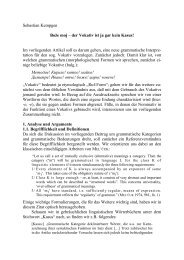
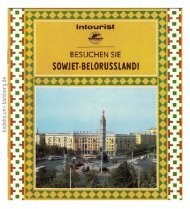
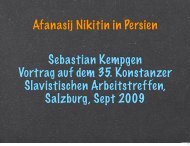
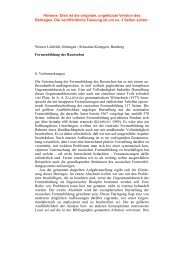

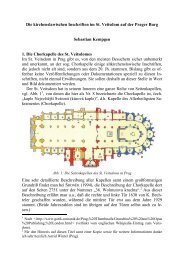
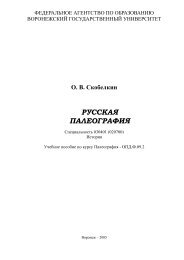

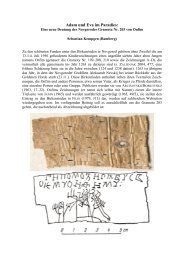
![30 Nezhit-Amulett [96] - Kodeks](https://img.yumpu.com/17746071/1/184x260/30-nezhit-amulett-96-kodeks.jpg?quality=85)

